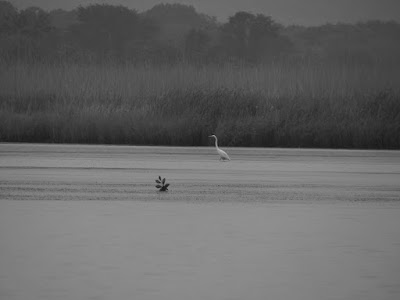I spot two Green Herons between the railroad bridge and the Post Road bridge. There are a lot of Sandpipers and Yellow-Legs along with a few Plovers. Also note that there are more Great Blue Herons than usual. They are all busy feeding from the exposed silt banks of the low tide.
 |
| Great Egret |
 |
| Yellow-Legs |
I expected a wade, but the Gravel Flats have just enough water to float the canoe. There are a couple large mud flats here and the shore birds are darting about feeding on mud critters. It's a few Great and Snowy Egrets, Great Blue Herons, Yellow-Legs, and one Common Snipe. Kingfishers are in the overhanging trees and two unidentified mid-sized hawks (possibly Coopers) are overhead. Definitely busy.
 |
| Yellow-Legs and Common Snipe |
In that short time, 15 minutes or so, a couple of inches of water have been added to the Gravel Flats...the tide is coming in quick.
As I return I think about the seasons. Most of us follow an astronomical meter - the year broken into four seasons based on, at least from our common perspective, the length of day. A people that is in touch with their environment might see the seasons differently. The Sami traditionally had eight seasons that were based on the behaviors of reindeer. The seasons varied in lengths from a 10-15 day calving season to a 5 month winter. The East River must have its own seasons. I'll have to think about what markers would be most logical. I can see the possibility for a Willet Nesting season, maybe a fall migration season, maybe the doubling of osprey season, and definitely the greening of the marsh. To me, today feels like a change in season.
 |
| Near minimum water Sneak passage |




































